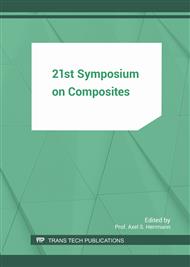[1]
F. Pottmeyer, M. Weispfenning, K. A. Weidenmann, Research of the Load Bearing Capacity of Inserts embedded in CFRP under different Loading Conditions, World Academy of Science, Engineering and Technology, International Journal of Chemical, Molecular, Nuclear, Materials and Metallurgical Engineering 11 (2017).
DOI: 10.4028/www.scientific.net/kem.742.636
Google Scholar
[2]
P. P. Camanho, M. Lambert, A design methodology for mechanically fastened joints in laminated composite materials, Composites Science and Technology 66 (2006) 15 3004–3020.
DOI: 10.1016/j.compscitech.2006.02.017
Google Scholar
[3]
I. Eriksson, On the Bearing Strength of Bolted Graphite/Epoxy Laminates, Journal of Composite Materials 24 (1990) 12 1246–1269.
DOI: 10.1177/002199839002401201
Google Scholar
[4]
Y. Xiao, T. Ishikawa, Bearing strength and failure behavior of bolted composite joints (part I. Experimental investigation), Composites Science and Technology 65 (2005) 7 1022–1031.
DOI: 10.1016/j.compscitech.2005.02.011
Google Scholar
[5]
B. Kolesnikov, L. Herbeck, A. Fink, CFRP/titanium hybrid material for improving composite bolted joints, Composite Structures 83 (2008) 4 368–380.
DOI: 10.1016/j.compstruct.2007.05.010
Google Scholar
[6]
J. Gebhardt, J. Fleischer, Experimental Investigation and Performance Enhancement of Inserts in Composite Parts, Procedia CIRP 23 (2014) 7–12.
DOI: 10.1016/j.procir.2014.10.084
Google Scholar
[7]
B. Ferret, C. Anduze, C. Nardari, Metal inserts in structural composite materials manufactured by RTM, Composites Part A 29 (1998) 693–700.
DOI: 10.1016/s1359-835x(97)00107-3
Google Scholar
[8]
C. Hopmann, M. L. Fecher, L. Lineman, R. Bastian, T. Gries, A. Schnabel, C. Greb: Comparison of the properties of Onserts and Inserts for a high volume production of structural composite parts, Journal of Plastics Technology 9 (2013) 4 179–206.
Google Scholar
[9]
J. Fleischer, J. Gebhardt, Experimental Investigation of Metal Inserts Embedded in Composite Parts Manufactured by the RTM Process, 13th Japan International SAMPE Symposium and Exhibition, Nagoya, Japan, (2013).
Google Scholar
[10]
M. Schwarz, M. Magin, C. Peil, H. Schürmann, Thin-walled FRP-laminates and local bending moments - incompatible or solvable by a skillful design?, 7. Internationale Tagung für Verstärkte Kunststoffe und Duroplastische Formmasse (2004).
Google Scholar
[11]
J. Gebhardt, F. Pottmeyer, J. Fleischer, K. A. Weidenmann, Characterization of Metal Inserts Embedded in Carbon Fiber Reinforced Plastics, MSF 825-826 (2015) 506–513.
DOI: 10.4028/www.scientific.net/msf.825-826.506
Google Scholar
[12]
J. Gebhardt, Strukturoptimierung von in FVK eingebetteten metallischen Lasteinleitungselementen, Dissertation Karlsruher Institut für Technologie (KIT), wbk - Institut für Produktionstechnik, Shaker Verlag, 1. Auflage (2016), Karlsruhe.
DOI: 10.25368/2021.61
Google Scholar
[13]
W. Bleck, A. Frehn, P. Larour, G. Steinbeck, Untersuchungen zur Ermittlung der Dehnratenabhängigkeit von modernen Karosseriestählen, Materialwissenschaft und Werkstofftechnik 35 (2004) 8 505–513.
DOI: 10.1002/mawe.200400767
Google Scholar
[14]
Y. Zhou, Y. Wang, S. Jeelani, Y. Xia, Experimental Study on Tensile Behavior of Carbon Fiber and Carbon Fiber Reinforced Aluminum at Different Strain Rate, Appl. Compos. Mater. 14 (2007) 1 17–31.
DOI: 10.1007/s10443-006-9028-5
Google Scholar
[15]
N. Taniguchi, T. Nishiwaki, H. Kawada, Tensile strength of unidirectional CFRP laminate under high strain rate, Advanced Composite Materials 16 (2007) 2 167–180.
DOI: 10.1163/156855107780918937
Google Scholar
[16]
J. Harding, L. M. Welsh, A tensile testing technique for fibre-reinforced composites at impact rates of strain, Journal Mater. Sci. 18 (1983) 6 1810–1826.
DOI: 10.1007/bf00542078
Google Scholar
[17]
I. M. Daniel, H. M. Hsiao, R. D. Cordes, Dynamic response of carbon/epoxy composites, High strain rate effects on polymer, metal and ceramic matrix composites and other advanced materials 48 (1995) 167–177.
Google Scholar
[18]
L. M. Welsh, J. Harding, Effect of strain rate on the tensile failure of woven reinforced polyester resin composites, J. Phys. Colloques 46 (1985) C5 405-414.
DOI: 10.1051/jphyscol:1985551
Google Scholar
[19]
S. E. Groves, R. J. Sanchez, R. E. Lyon, A. E. Brown, High Strain Rate Effects for Composite Materials, American Society for Testing and Materials (ASTM STP, 1206), Composite materials. Testing and design, (1993) 162-162-15.
DOI: 10.1520/stp12626s
Google Scholar
[20]
A. Gilat, R. K. Goldberg, G. D. Roberts, Experimental study of strain-rate-dependent behavior of carbon/epoxy composite, Composites Science and Technology 62 (2002) 10-11 1469–1476.
DOI: 10.1016/s0266-3538(02)00100-8
Google Scholar
[21]
C. Cazeneuve, J. -C. Maile, Ètude du comportement de composites à fibres de carbone sous differentes vitesses de deformation, J. Phys. Colloques 46 (1985) C5, 551-556.
DOI: 10.1051/jphyscol:1985571
Google Scholar
[22]
J. T. Tzeng, A. S. Abrahamian, Dynamic compressive properties of composites at interior ballistic rates of loading—Experimental method., Composites Engineering 5 (1995) 5 501–508.
DOI: 10.1016/0961-9526(95)00021-e
Google Scholar
[23]
T. Shimokawa, H. Katoh, Y. Hamaguchi, S. Sanbongi, H. Mizuno, H. Nakamura et al., Effect of Thermal Cycling on Microcracking and Strength Degradation of High-Temperature Polymer Composite Materials for Use in Next-Generation SST Structures, Journal of Composite Materials 36 (2002).
DOI: 10.1177/0021998302036007469
Google Scholar
[24]
L. J. Hart-Smith, Adhesive-bonded double-lap joints, NASA CR-112235 (1973), Houston, USA.
Google Scholar
[25]
F. S. Jumbo, I. A. Ashcroft, A. D. Crocombe, M. M Abdel Wahab: Thermal residual stress analysis of epoxy bi-material laminates and bonded joints, International Journal of Adhesion and Adhesives 30 (2010) 7 523–538.
DOI: 10.1016/j.ijadhadh.2010.03.009
Google Scholar
[26]
Y. Yu, I. A. Ashcroft, G. Swallowe, An experimental investigation of residual stresses in an epoxy–steel laminate, International Journal of Adhesion and Adhesives 26 (2006) 7 511–519.
DOI: 10.1016/j.ijadhadh.2005.07.006
Google Scholar
[27]
T. A. Bogetti, J. W. Gillespie, Process-Induced Stress and Deformation in Thick-Section Thermoset Composite Laminates, Journal of Composite Materials 26 (1992) 5 626–660.
DOI: 10.1177/002199839202600502
Google Scholar
[28]
J. F. Timmerman, M. S. Tillman, B. S. Hayes, J. C. Seferis, Matrix and fiber influences on the cryogenic microcracking of carbon fiber/epoxy composites, Composites Part A: Applied Science and Manufacturing 33 (2002) 3 323–329.
DOI: 10.1016/s1359-835x(01)00126-9
Google Scholar


